A Walk, A Drive, a View
This is a high drive circuit from Céret, along winding, sometimes narrow roads, through unexploited countryside, remote hamlets and villages with great walking opportunities and superb views. Shops, cafés and restaurants are few and far between, but views and picnic spots abound! Passengers in the back might consider taking a sick bag if they have delicate tummies!
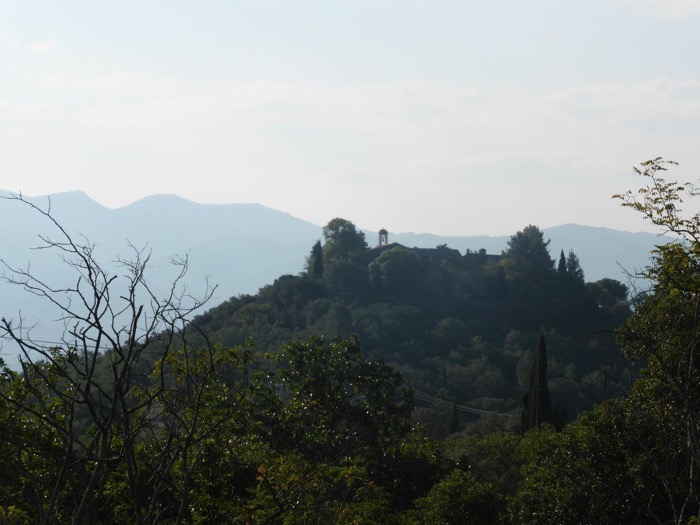
Our day out starts from the Pont du Diable in Céret, 14th-century bridge with 46-metre span, at the time of its construction the world’s largest bridge arch.
Take the D615 signposted Llauro and Oms, and after a couple of kilometres, be careful not to miss the sign on the right, taking you to our first stop, L’Ermitage de St Ferréol.
This 13th century chapel had the hermitage added in the 18th century. Other buildings were tacked on later to accommodate the many visiting pilgrims.
The chapel bells, named Maria, Margarita and Salvaterra, date back to 1608.
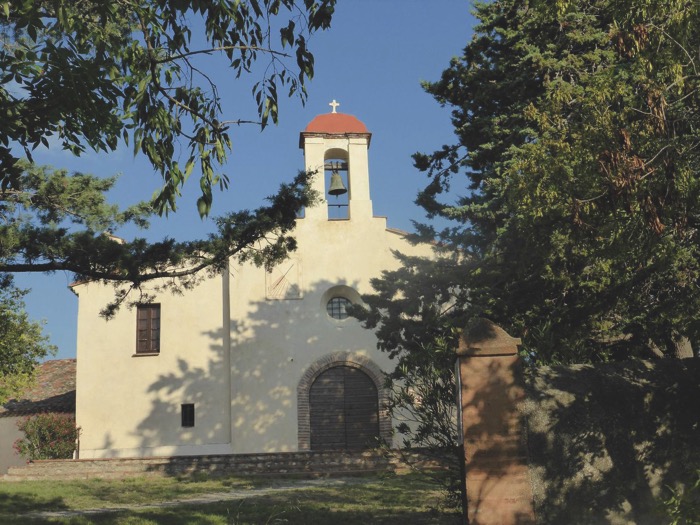
Views from this tranquil spot are enormous, overlooking Céret, and the surrounding plains and mountains. Shady oaks, picnic tables and designated BBQ spaces make it a delightful pause for a bite to eat, a spiritual siesta or quiet contemplation.
Back onto the D615, some may wish to turn left and head back to Céret, a visit to the peaceful chapel an outing in itself. The curious and adventurous, however, will turn right and continue up the twisty, turny road, taking a left turn towards Calmeilles and Oms after about 3 km.

Time for another stop, this time to stock up on foie gras and all its associated products at Le canard bien élevé du Mas Cané www.lecanardbienelevedumascane.com)
Turn off right and follow the signs down one of those ‘Aren’t-we-there-yet?’ tracks, until you arrive at the farm shop. Don’t forget to take a cool box – we’ve a long way to go yet!
Head back to the main road and continue towards Oms, (Catalan for Elm), with its pretty, cobbled streets, and imposing 11th Century church. If the bar, and ‘alimentation’ is open, you may wish to stop a while, otherwise it is onwards and upwards along oak lined roads with fantastic glimpses through the trees, of the views that await. Pass Calmeilles, tiny, immaculate pedestrian village, with interesting Romanesque church, first mentioned in 959.

Many of these villages have mining origins. The Romans were the first to extract the mineral, building roads for easy access to Perpignan, crafting iron wheels for carts, used to transport the iron to make armaments for their vast empire. The Romans left, but the industry continued and prospered. Small settlements grew up in the Vallespir, the Conflent and the valley of the Lentilla, to house the families of miners, muleteers, blacksmiths, and transporters.
From 1950 onwards, the mines could no longer compete with the rest of the world, and closed down. Today, many of the ancient villages have been saved from ruin by second home and gite owners, immaculately restored remnants of the mining age.
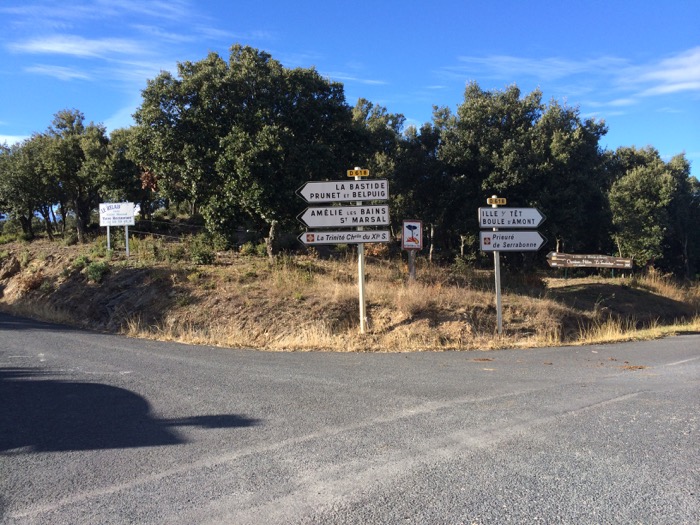
Continue climbing until you arrive at the Col du Fortou crossroads, at 655 metres altitude, with signs indicating straight on for Ille sur Têt or left towards Amélie. We will be taking a left, heading for La Trinité, but the intrepid may wish to take a little detour to the right, down a narrow road, to the tiny hamlet of Prunet. Blink and you will miss it. Clustered around a miniscule 10th century church beneath a couple of two hundred year old oak trees in whose branches peacocks roost, the graveyard has some fine examples of traditional wrought iron crosses.
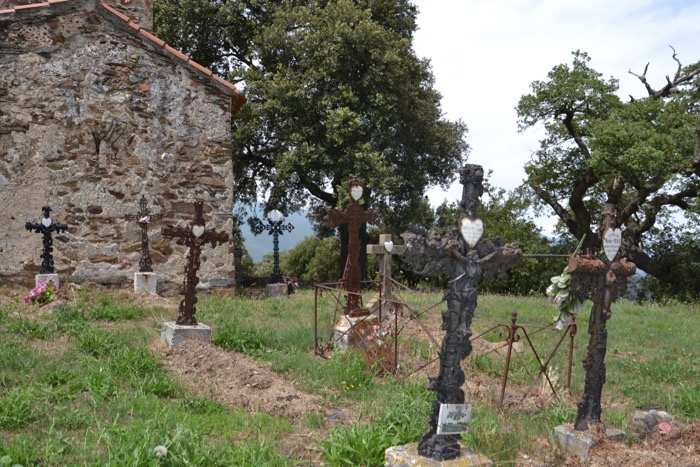
Back to the crossroads, and arrive quickly at another neat little hamlet – La Trinité. Next to the small Mairie of Prunet and Belpuig is the pretty 11th century Chapelle de la Trinité – religious art and interesting door – but the highlight of this hamlet has to be the views. Behind the church, a steep 10 minute climb will take you to a ruined château. On a clear day, the views will take your breath away. Take a picnic and combine food, drink, and amazing views – or drive into the next village, La Bastide, (another detour) for lunch at the pleasant little café restaurant.
After a well deserved rest, continue over the Col Xatard (pronounced ch) to St Marsal, more splendid views, and colourful, terraced, cobbled streets. A fairly steep climb up through the village will bring you to Le Relais de St Marsal, mairie-owned café-restaurant, perfect for a late lunch or a cold beer in the restful square on a sunny autumn day. If it’s closed, the épicerie on the main road has bread, pizza, patisserie and coffee to take away.
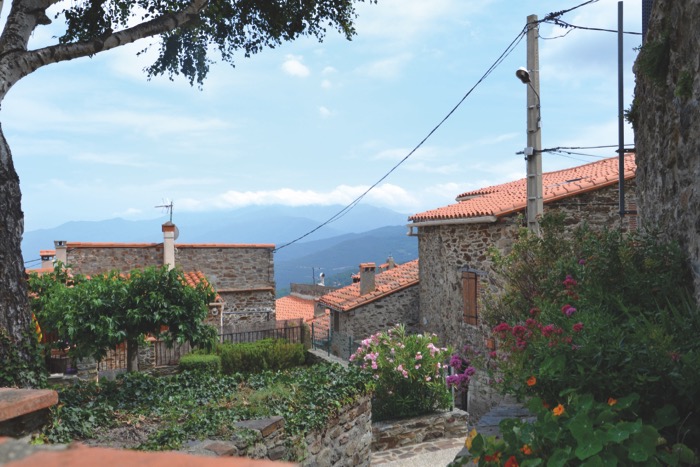
To stretch the legs a little more, follow the sign to the right of the church, leading to the dolmen and the ice well.
From St Marsal, walkers can also reach ‘La Ligne ‘, the railway line that used to carry the iron ore from the mines at la Pinosa and Manarots to Formentère. Now without rails, it is a grassy walk around a mountain contour, with spectacular views of the Mediterranean, the plain of Roussillon, the massif du Canigou and the border with Spain along the Alberes. (More on this walk)
Back in the saddle, head out of St Marsal, maybe popping into the pottery on the right as you leave the village. After around three km, look out on a left hand turn for a (second) bridge with water running below and a derelict and overgrown former Catalan blast furnace on your left.

Park here, at the side of the road and walk back to the bridge, where a short path brings you out at a series of magical rock pools and little waterfalls. Shhhhh! This hidden gem is our secret! Kick off your shoes and socks, cool your feet, close your eyes and listen to the gentle trickle of the waterfall into the pool. Nearby, there is also the possibility of walking to the Col de Formentère, the Tour de Batère or along the old mine railway ending in an eerie, deserted complex of mine buildings – but that is for another day, a fascinating day out in its own right.
Continue down through the village of Taulis, turn right and continue downwards, until a fork in the road indicates left for Céret, and straight on for Amélie.
In autumn, the colours in these wooded valleys, rich with sweet chestnut trees, beech, fir, and micocouliers are particularly beautiful.
Spare a thought for the driver. He/she can’t really appreciate the magnificent views, as the roads are mainly narrow and need concentration, so make sure that you spoil him/her on all the stops, share the driving, or cut this day up into several shorter adventures. Have a lovely day, however you play it!


This is a lovely drive with great views and stop off places. We did not do them all as the drive is much further than it seems on a map but the stops at L’ermitage st Ferreol and Prunet ( go inside the tiny church) are excellent, especially as we had the places to ourselves.
A couple of points to note
1. The turn off to L’ermitage is approx 5 km out of Ceret
2. The detour to Bastide is a long one and not really worth it. Note also that you have to go back on yourself after leaving Bastide in order to reach St Marcal.
Otherwise a really good drive out – ensure that you have plenty of fuel though as there are no filling stations!